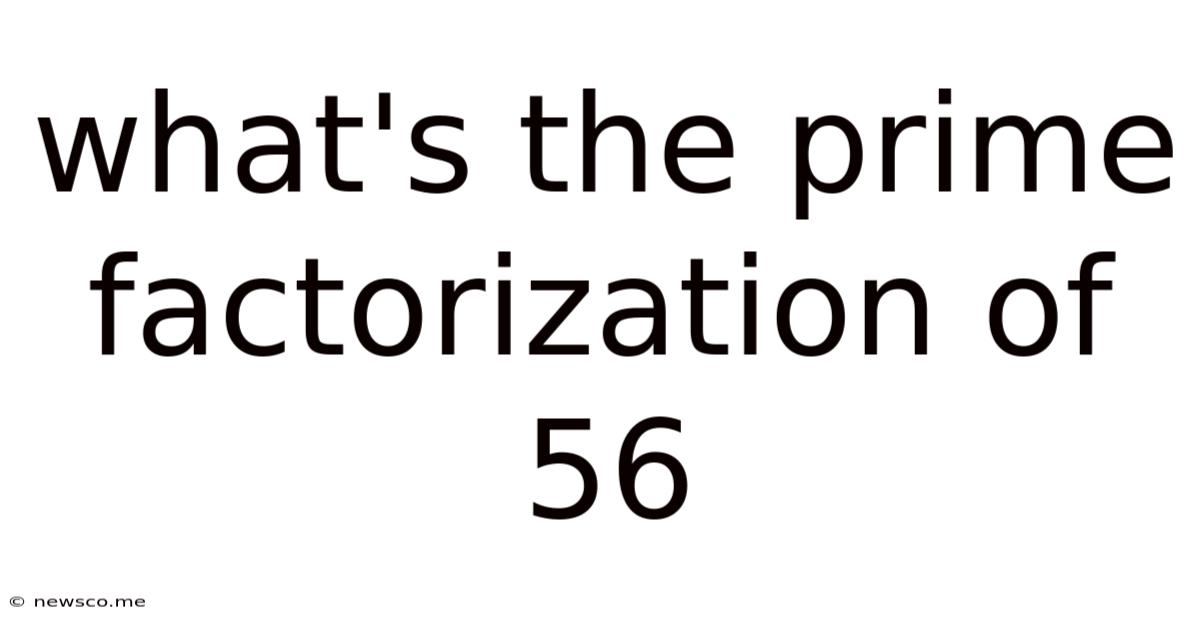What's The Prime Factorization Of 56
News Co
Apr 24, 2025 · 5 min read

Table of Contents
What's the Prime Factorization of 56? A Deep Dive into Prime Numbers and Factorization
Finding the prime factorization of a number might seem like a simple mathematical task, but it's a fundamental concept with far-reaching implications in number theory and cryptography. This article will delve into the prime factorization of 56, explaining the process step-by-step, exploring the properties of prime numbers, and highlighting the significance of prime factorization in various fields.
Understanding Prime Numbers
Before we tackle the prime factorization of 56, let's solidify our understanding of prime numbers. A prime number is a whole number greater than 1 that has only two divisors: 1 and itself. This means it cannot be divided evenly by any other number without leaving a remainder. The first few prime numbers are 2, 3, 5, 7, 11, 13, and so on. They are the building blocks of all other whole numbers.
Key Characteristics of Prime Numbers:
- Divisibility: Only divisible by 1 and itself.
- Infinitude: There are infinitely many prime numbers. This was proven by Euclid centuries ago.
- Distribution: While there's no simple formula to predict the next prime number, their distribution among integers is a subject of ongoing mathematical research.
- Uniqueness: The Fundamental Theorem of Arithmetic states that every whole number greater than 1 can be expressed as a unique product of prime numbers (ignoring the order of the factors). This uniqueness is crucial to many mathematical applications.
Finding the Prime Factorization of 56
Now, let's break down 56 into its prime factors. We'll use a method called the factor tree. This involves repeatedly dividing the number by its smallest prime factor until we are left with only prime numbers.
-
Start with the number 56: We begin by identifying the smallest prime number that divides 56. This is 2.
-
Divide by 2: 56 divided by 2 is 28.
-
Continue dividing by 2: 28 is also divisible by 2, resulting in 14.
-
Another division by 2: 14 is again divisible by 2, giving us 7.
-
The last prime factor: 7 is a prime number. We've reached the end of our factorization.
Therefore, the prime factorization of 56 is 2 x 2 x 2 x 7, which can also be written as 2³ x 7.
Visualizing the Factor Tree for 56
Here's a visual representation of the factor tree:
56
/ \
2 28
/ \
2 14
/ \
2 7
The Significance of Prime Factorization
The seemingly simple process of prime factorization has profound implications across various fields:
1. Cryptography
Prime factorization is at the heart of many modern encryption algorithms. The difficulty of factoring extremely large numbers into their prime components is the basis for the security of systems like RSA encryption, widely used to secure online transactions and communications. Breaking these encryption methods would require solving the factorization problem for incredibly large numbers—a computationally intensive task even for the most powerful supercomputers.
2. Number Theory
Prime factorization is a cornerstone of number theory, a branch of mathematics that studies the properties of integers. Many advanced theorems and conjectures in number theory rely on understanding prime numbers and their distribution. For example, the Riemann Hypothesis, one of the most important unsolved problems in mathematics, relates to the distribution of prime numbers.
3. Computer Science
Efficient algorithms for prime factorization are crucial in computer science. These algorithms are used in various applications, including cryptography, random number generation, and data compression. The development of faster and more efficient factorization algorithms is an area of ongoing research.
4. Abstract Algebra
Prime factorization has applications in abstract algebra, a branch of mathematics that deals with abstract algebraic structures like groups, rings, and fields. The concept of prime factorization extends to these abstract structures, providing insights into their properties and relationships.
Beyond 56: Exploring Prime Factorization of Other Numbers
The process of finding the prime factorization is consistent for all whole numbers greater than 1. Let's briefly consider a few more examples:
- Prime Factorization of 12: 2 x 2 x 3 = 2² x 3
- Prime Factorization of 30: 2 x 3 x 5
- Prime Factorization of 100: 2 x 2 x 5 x 5 = 2² x 5²
- Prime Factorization of 1001: 7 x 11 x 13
Advanced Techniques for Prime Factorization
For larger numbers, the simple factor tree method becomes cumbersome. More sophisticated algorithms are used, including:
- Trial Division: This involves systematically testing for divisibility by prime numbers. It's efficient for smaller numbers but becomes slow for very large ones.
- Pollard's Rho Algorithm: A probabilistic algorithm that is more efficient than trial division for finding factors of larger numbers.
- General Number Field Sieve (GNFS): This is the most efficient known algorithm for factoring very large numbers and is used in breaking cryptographic systems.
Conclusion: The Enduring Importance of Prime Factorization
The prime factorization of 56, seemingly a simple calculation, provides a gateway to understanding the profound role of prime numbers in mathematics, computer science, and cryptography. The quest to efficiently factor large numbers continues to drive research and innovation, underpinning the security of our digital world and pushing the boundaries of mathematical understanding. From the seemingly simple factor tree to the complexities of the GNFS algorithm, the pursuit of prime factorization reveals a deep and fascinating aspect of the mathematical landscape. Understanding this fundamental concept provides a solid foundation for exploring more advanced areas of mathematics and its applications.
Latest Posts
Related Post
Thank you for visiting our website which covers about What's The Prime Factorization Of 56 . We hope the information provided has been useful to you. Feel free to contact us if you have any questions or need further assistance. See you next time and don't miss to bookmark.